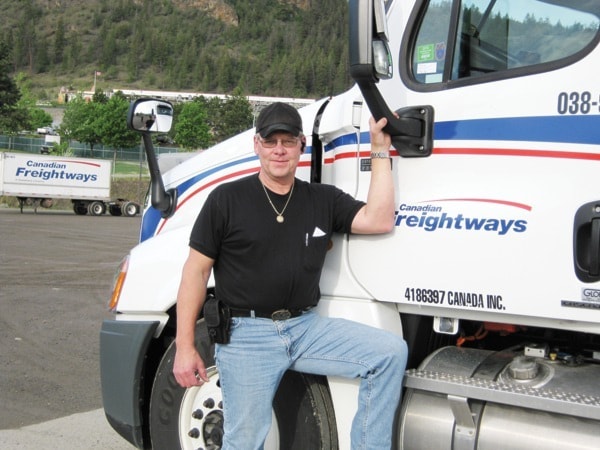Note to new truckers eager to hit the road in the big rig.: watch and learn from those who’ve gone before you (and maybe ended up in the ditch), take the best from each driver and throw the rest in the trash.
And having a healthy dose of fear helps too, says Canada’s Driver of the Year, who says he doesn’t want to report a wreck to his supervisor.
“I find the biggest thing in my career … you learn from other people’s mistakes. Every time you see a collision, you always ask yourself, ‘How come that happened?’ “ says Maple Ridge resident John Beeler.
“Most of the time, the causes of collisions are speed, too much of it, eh. Just over-driving the conditions, being in too much of a hurry, over-driving winter conditions.”
Beeler received the recognition in December from the Canadian Trucking Alliance. A few months before that he was named B.C. Driver of the Year by the B.C. Trucking Association.
He notes the Canada-wide title is also given based on a driver’s contribution to the industry, not only his safety record.
But the latter no doubt figured largely.
For the last 36 years, Beeler has driven freight trucks up and down the roads of B.C., Alberta, Washington state and the Yukon, piling on just under five million kilometres of accident-free driving in the process.
To drive safely, he says you should know the vehicle and how it’s supposed to work and learn from other drivers. “Take the worst that you see and then wonder why that situation happened to that individual.
“Take the best that you can get from each person that you run into, then throw all the other stuff in the garbage. Mold yourself into being a safety-concious person.”
Most likely, the axiom ‘haste makes waste’ figures in any driving disaster, such as a few weeks ago when snow and ice covered the Coquihalla Highway.
Beeler was westbound to Vancouver but decided to shut it down and wait until weather conditions improved. In the three-plus decades he’s been driving, he’s only done that five times. He wasn’t afraid of sliding over a cliff, but more worried about other rigs without tire chains hitting him.
“Taking chances doesn’t pay,” Beeler says.
If he’s delayed, all his company wants is a phone call, no other questions are asked because the company knows it’s his call. While he rolled into Burnaby a few hours late, nobody said a peep.
“I’m the captain of my ship,” Beeler explains.
The same advice applies to the general motoring public on the highway. “Throw your watch away,” he says.
“Quit racing the clock to get where you’re going.”
Beeler was sharing his thoughts Wednesday via hands-free device as he rolled westbound through Abbotsford on Highway 1, heading to Burnaby.
He was driving a 2010 Cascadia Freightliner with 530 horsepower. While Beeler says there’s nothing fancy in it, the cab comes with an on-board computer that tracks the driver’s hours behind the wheel, the vehicle and engine speed and location.
That all plays a role as the company monitors drivers to ensure they follow the new trucking regulations that limit driver’s time to 13 hours behind the wheel per 24-hour period.
Beeler says with vehicles changing and improving all the time, drivers have to keep up to date. “Knowledge is key.”
And for any trucker just starting out: get as much experience as you can, he adds, then find yourself a good company to work for.
Beeler’s been with Canadian Freightways for 31 years and says the company’s priority is safety.
“We don’t want collisions.”
If truck isn’t safe, it doesn’t roll until it is. And if it can’t be repaired, it’s replaced.
Winter driving tires are routinely replaced when they hit 40-per-cent wear remaining.
While vehicles are changing constantly, it’s not the case with B.C. roads.
Beeler likes the Coquihalla, the multi-lanes and easy driving, even though many motorists and truckers have trouble with the steep hills.
But he’s not as impressed with the stretch of the Trans-Canada Highway east of Sicamous (east of Kamloops), Roger’s Pass to the Alberta border, even though the Kicking Horse Canyon Bridge improved a short section of that east of Golden.
Much of the Trans-Canada remains only two-lanes on the main east-west corridor linking B.C. to the rest of the country.
There are too many accidents on that section, involving both truckers and the general public, and Beeler says the road is still in the Stone Age.
“It’s pretty much an ugly road, for being rough. It really hasn’t changed as much as I’d like it to. “It’s a demanding piece of road that a lot of people overdrive too much.
“It’s been that way for years. It should change at some point and be something like the Coquihalla. It just has to be improved.
“I bet you they’ve done more changes on the Alaska Highway than they’ve done on that [Trans-Canada Hwy.] section over there. For the amount of traffic that goes over that road it’s just plain outdated.”
